Evaluation of the use of Training and Awareness and the Promotion of the Safe use, Handling, Application, Storage, and Disposal of Pesticides as a Risk Reduction Strategy to Pesticide Exposure: A Case Study with Farmers in Ruby, Parika and Naamryck Farming Communities in Guyana
Suresh Amichand1*, Trecia David1, and Rajendra Persaud2*
1Pesticides and Toxic Chemicals Control Board (PTCCB), Mon Repos, East Coast Demerara, Guyana
2Guyana Rice Development Board (GRDB), Rice Research Station (RRS), Burma, Mahaicony, East Coast Demerara, Guyana
Submission: March 23, 2024;Published: April 01, 2024
*Corresponding author: Rajendra Persaud, Guyana Rice Development Board, Rice Research Station, Burma, Mahaicony, East Coast Demerara, Guyana. Email: rajpersaud25@yahoo.com/rpersaud@grdb.gy, and Suresh Amichand, Pesticides and Toxic Chemicals Control Board, Mon Repos, East Coast Demerara, Guyana. Email: amichands@yahoo.com
How to cite this article: Suresh Amichand*, Trecia David, and Rajendra Persaud. Evaluation of the use of Training and Awareness and the Promotion of the Safe use, Handling, Application, Storage, and Disposal of Pesticides as a Risk Reduction Strategy to Pesticide Exposure: A Case Study with Farmers in Ruby, Parika and Naamryck Farming Communities in Guyana. JOJ Hortic Arboric. 2024; 4(2): 555635. DOI 10.19080/JOJHA.2024.04.555635.
Abstract
The risk reduction strategy for pesticide exposure was conducted with farmers in the Ruby, Parika and Naamryck (RPN) farming areas. A case study method was adopted using pre and post-intervention survey tools (Appendix I and II) to assess the effectiveness of the strategy. Twenty-eight (28) participants consisting of farmers from RPN part take in the intervention exercise during 2022. The results of the survey demonstrated a 60% increase in understanding that all pesticides are poisons. Likewise, 80% increase in understanding that pesticides can impact human health and the environment, while 40% more now understand that there are alternatives to toxic pesticides. Further, > 80% of the respondents identify farmers, children, women, and the elderly as the most vulnerable group. In addition, 80% of the respondents demonstrated knowledge of pesticide labels in the pre-survey, while 100% in the post- survey agreed that the dose rates on pesticide labels should be used. Likewise, in the post-survey 90% of respondents were able to identify the different classes of pesticides and 100% demonstrated knowledge of color bands and toxicity levels. Response to PPE remained the same before and after the exercise, where 80% indicated that it is extremely important and 20% very important. Also, 100% indicated that morning was the most suitable time for the application of pesticides and 90% said evening. Surprisingly, even with the training 10% of respondents indicated that spraying against the wind was acceptable.
However, 100% agreed that there should be no smoking when applying pesticides. Further, the pre-survey revealed that 30% of the respondents were not using designated clothing. Interestingly, following the exercise 100% reported that they are utilizing designated clothing. Also, 100% of participants agreed that proper pesticide storage is always important and 100% agreed to better disposal practices of empty pesticide containers. In general, participants found the information shared and topics covered useful (100%), relevant to the group (100%), clear in presentation, and tailored to the target audience (100%) to ensure as much knowledge gain as possible. All participants expressed satisfaction with the exercise and requested additional and continuous training annually. Further, 100% of those surveyed indicated that they have gained knowledge from the training provided on the safe use, handling, storage, and disposal of pesticides and this will be shared with other farmers. It can be concluded that the aim and objectives of the intervention were met. However, the actuality of farmers practicing the same in the fields was not an eventuality indicating that more training, awareness, and education on modern trends of health and environmentally friendly agricultural methods should be encouraged to get them to adopt and implement the best practices in the safe use and management of pesticides in the farms.
Keywords: Pesticide; Risk reduction; Training; Awareness; Safety practices; Storage; Disposal
Abbreviations: PTCCB: Pesticide and Toxic Chemical Control Board; PPE: Personnel Protective Equipment; RPN: Ruby, Parika and Naamryck; NAREI: National Agriculture Research and Extension Institute; SU: Savar Upazila; MU: Mehendiganj Upazila; GRDB: Guyana Rice Development Board; RRS: Rice Research Station
Introduction
The present world population is estimated to be over 7.2 billion and to feed the growing population and fulfill their daily dietary needs, food producers have to rely heavily on the use of agro-pesticides to secure and enhance agriculture productivity [1]. In recent years, various agro-pesticides have played an essential role in agricultural practices globally [2]. Unlike most other chemical products, pesticides are deliberately used and released into the environment to control weeds, pests, diseases, and any other organism or conditions that may harm cultivated crops [3]. More than over 2 million tons of pesticides are currently applied to crops worldwide each year to increase productivity and reduce losses from pests and diseases [4]. One of the core principles in empowering chemical users towards risk reduction is through education and knowledge sharing imparted through various educational tools, mainly awareness and training [5]. Yuantari et al. [6] reported that knowledge transfer is integral in practice as farmer’s behavior towards pesticide use has become cultural and habitual. Likewise, Moreira and Da Silva [7] reported that a multidisciplinary and more effective training exercise must be delivered to agriculture operators, especially farmers and farmworkers to enhance pesticide-safe usage and this itself will empower workers to adopt more conscious and safer behaviors while using pesticides.
Similar sentiments were echoed by Lim et al. [1] where these researchers pointed out that poor safety practices in pesticide handling contribute to the severe consequences of cases of pesticide poisoning globally. Hence the need to educate the farmers and their families about the appropriate usage of pesticides to improve yield as well as quality of crops without harming themselves and the environment. Additionally, according to a recent study conducted by the PTCCB (2022), examining ‘Pesticide Exposure and Impacts on Human Health of Small Farmers of Ruby, Naamryck and Parika, Region 3’, found and reported that 98% of the farmers are involved in various activities using pesticides from mixing to application of which 86% of the farmers reported that they carry out their own pesticide application, with no farmer using the recommended personnel protective equipment (PPE). The research further revealed that 54% of the surveyed farmers use ordinary clothing dedicated to pesticide application, while an alarming 46% use ordinary clothing that is worn for other occasions. However, 89% of the farmers surveyed never use PPE when applying pesticides. These findings were supported by Zyoud et al. [8] who argued that increasing knowledge through training and awareness is likely to increase the use of PPE and promote improved pesticide use practices. Likewise, Asharose and Sasi [9], reported that training and awareness workshops can bring about a positive change in the level of understanding but also emphasized that these activities are not a short-term affair, therefore requiring sustainability for inculcating risk reduction as a part of people’s life and culture.
Taking all this into account, this paper set out to examine the use of training and awareness through the delivery of face-to-face exchange using power-point presentations as an educational tool. The paper particularly focused on the application of educational tools for risk reduction through the handling and use of pesticides. This risk reduction tool will be implemented among small farmers in the Ruby, Parika, and Naamryck (RPN) area of region # 3 in Guyana. This paper therefore examined the effectiveness of the risk reduction tool in effecting change and reducing risk to human health and the environment in the study area; with the primary objective to implement awareness and training programmes on the safe use and handling of pesticides.
The aim of the risk reduction strategy focuses on awareness, education and training programmes as an effective way of reducing the risk of exposure to pesticides, with the view of ensuring the safe handling and use of pesticides by farmers in the study area, RNP. The training and awareness allow for open engagement with farmers through pre and post-intervention survey tools, information exchange, practical demonstration, and knowledge transfer. In this regard the secondary objectives are as follows:
To explain risks and potential acute and chronic effects on human health and the environment.
To ensure proper use practices when handling and applying pesticides.
To reduce the risk of exposure through sound pesticide use practices when handling and applying pesticides.
To examine how this programme impacts the pesticide use culture of farmers in the study area, and
To identify the main problems and difficulties encountered upon the implementation of the programme.
This risk communication strategy considers the role and impact of training and awareness in reducing the risk associated with the use of pesticides.
Introduction
Training and Awareness Exercise for Farmers and Farmworkers of the Ruby, Parika and Naamryck (RPN) Farming Communities
This intervention was planned and implemented by a team of the Pesticides and Toxic Chemicals Control Board (PTCCB). The team comprised Mr. Suresh Amichand, Deputy Registrar and Inspectors who facilitated a training and awareness exercise for farmers and farmworkers of the Ruby, Parika and Naamryck (RPN) Farming Communities. All activities were planned and conducted during the period September -October 2022.
The PTCCB team along with Extension officers of the National Agricultural Research and Extension Institute (NAREI) visited RPN and invited more than fifty farmers and/or farmworkers to participate in the planned exercise for 14th October 2022. The training information was delivered using a power-point presentation and included two practical demonstrations (Appendix III). The presentation during the training and awareness exercise at RNP covered the following topics:
Pest and Pesticides
Handling, Use and Application Practices
Label and Dose Rates
Toxicity of Pesticides and Routes of Exposure
Storage of Pesticides
Disposal of Empty Pesticides Containers
Each farmer received the following (Figure 1 and Photograph in Appendix III)
Chemicals Resistant Gloves
Chemical Respirator
Measuring Utensil
Farmers Handbook

Monitoring and Evaluation of the Intervention
The effectiveness of the risk reduction strategy to reduce risk to human health and the environment was examined using pre and post-intervention survey Tools (Appendix 1 and 11). The pre-intervention survey was conducted in September 2022 in the Parika, Ruby and Naamryck Farming Communities targeting farmer’s and/or farmworkers before the delivery of the training and awareness exercise. This survey examined the farmer’s present knowledge and understanding of pesticides, safe use, handling, storage, and disposal. The pre-intervention survey tool is presented in Appendix I.
Subsequently, five (5) days following the delivery of the training, participants were exposed to a post-intervention survey retesting their knowledge and understanding in an effort to demonstrate knowledge gain, sound understanding of pesticides, risk associated with their use and likelihood to change improper pesticide use practices. The post-intervention survey tool is presented in Appendix II of this manuscript.
A detailed outline of the activities involved in the planning, implementation and delivery of the training and awareness program is presented in Table.
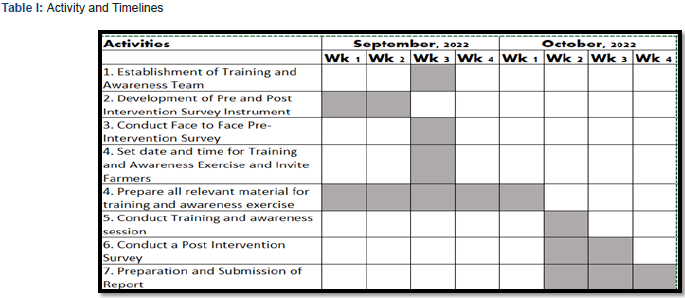
Data Collection, Analysis, and Presentation
All data collected from the pre and post-intervention survey tools were reviewed after the interviews and the answers to each question were coded and inputted into Microsoft (MS) Excel spreadsheets for further analysis using descriptive statistics. All calculations, percentages, charts, tables etc. were generated using the same MS Excel for the presentation of the results.
Results
Training and awareness exercises for farmers and farm workers of the Ruby, Parika, and Naamryck farming communities
The training and awareness program was conducted on the 14th of October 2022 and was attended by twenty-eight (28) people consisting of farmers, farmworkers, and members of their families. The target audience included both men and women
Analysis of the pre and post-intervention survey
Respondents’ knowledge of pesticides
The results of the pre and post-intervention survey highlighted a 60% gain in understanding of the respondents that all pesticides are poisons (Figures 2 and 3). Additionally, all the respondents (100%) demonstrated an understanding that pesticides can impact human health and the environment, whereas only 20% demonstrated an understanding before delete to the training. Forty percent (40%) more of those surveyed prior to the training now understand that there are alternatives to toxic pesticides such as bio-pesticides (Figures 2 and 3).
Respondents’, knowledge of vulnerable groups
In the post-intervention respondents were capable of identifying the vulnerable groups most at risk of pesticide exposure and poisoning. Ninety percent (90%) of the respondents reported that farmers and children are most at risk, while 80% reported both women and the elderly are at risk of experiencing adverse effects of pesticides (Figure 4).
Respondents use of dose rates
From the pre and post-intervention survey, it can be deduced that most of the respondents (>80%) demonstrated knowledge and understanding of information that is available on pesticide labels (Figure 5). This indicates that respondents are reading the labels. Even though 80% of the respondents demonstrated knowledge of pesticide labels, only 60% indicated that they would always use the dose rates provided on the label, 20% often and 10% sometimes (Figure 5). Additionally, 60% of the respondents indicated that using higher or lower dose rates is incorrect. However, in post-intervention, having recognized the importance of the dose rates and the dangers of using higher or lower rates, 100% of respondents agreed that the dose rates stipulated on the label should be used. While some knowledge gain can be seen, the maximum improvement demonstrated in this area was 30%.
Respondents, understanding of color bands
In the pre-intervention survey 90% of the respondents indicated that they are aware that pesticides have varying toxicity classes. However, in the post-intervention 90% of the respondents were able to identify that class I pesticides are more toxic than class III pesticides with 100% having knowledge of color bands and corresponding toxicity levels (Figure 6).
Respondents’ routes of exposure
As it relates to the ways in which pesticides enter the body, it is important to note that most farmers (90%) were aware that pesticides can enter the body during the pre-intervention survey. The post-intervention survey served to identify and strengthen their knowledge in this area, revealing that the majority (80 to 100%) are aware of the main routes of exposure as well (Figure 7).
Analysis of respondents’ use of PPE
The respondents view of using personnel protective equipment was the same before and following the training and awareness exercise (Figure 8), where 80% and 20% indicated that PPE was extremely important and very important, respectively during the pre and post-intervention survey (Figure 8).
Analysis of respondents, on application timing, wind direction when applying pesticides, and other safety practices
One hundred percent (100%) and ninety percent (90%) of the respondents, respectively indicated that the most suitable time for the application of pesticides is morning and evening. Likewise, before the training 20% of the respondents indicated that it was acceptable to spray against the wind, while 10% did not know the correct practice in this regard (Figure 9). However, even with the training 10% still indicated that it is acceptable to spray against the wind. The training and awareness sessions demonstrated some changes as all the respondents agreed that there should be no smoking when applying pesticides. The pre-intervention survey also revealed that not all respondents utilize designated clothing for pesticide application; 30% do not use designated clothing while 70% use designated clothing when applying pesticides, respectively (Figure 10). However, following the training and demonstration exercise all respondents (100%) reported that they are utilizing designated clothing to avoid unwanted exposure of themselves and others to pesticides.
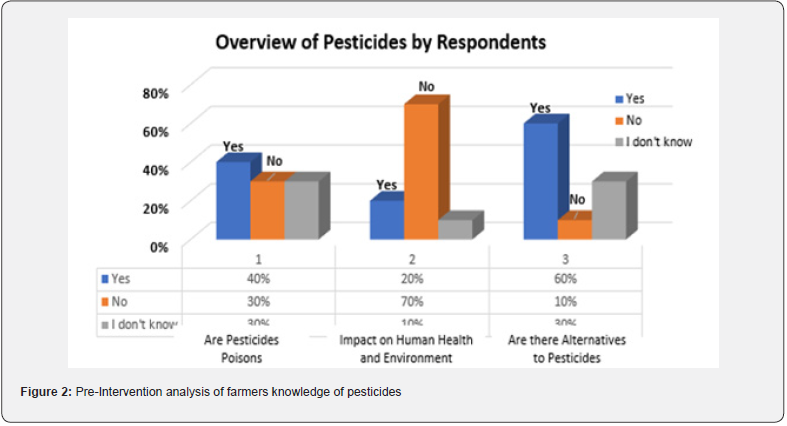
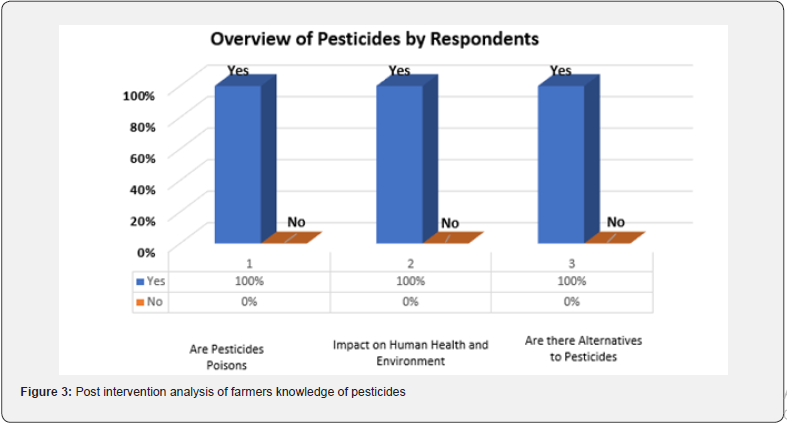
Analysis of respondents’ responses on access to pesticides and storage, disposal of empty pesticide containers
In Guyana, unwanted access to pesticides is a serious concern as this has often been linked to its high suicide rate. However, at the conclusion of the training and awareness exercise, all (100%) participants agreed that pesticide storage is important and to store pesticides correctly, mainly under lock and key, away from food, animal feed and children and/or unauthorized personnel.
Analysis of respondents’ responses on disposal of empty pesticide containers
The post-intervention survey reveals that all farmers agreed to better disposal practices for empty pesticide containers. The farmers welcomed and were pleased to report that they were able to triple rinse and return empty pesticide containers through the program that was recently launched by PTCCB. This program referred to as the empty pesticides container management scheme that is carried out in the targeted farming communities by the Pesticides and Toxic Chemicals Control Board (PTCCB) to encourage and enhances the safe disposal of empty pesticides containers.

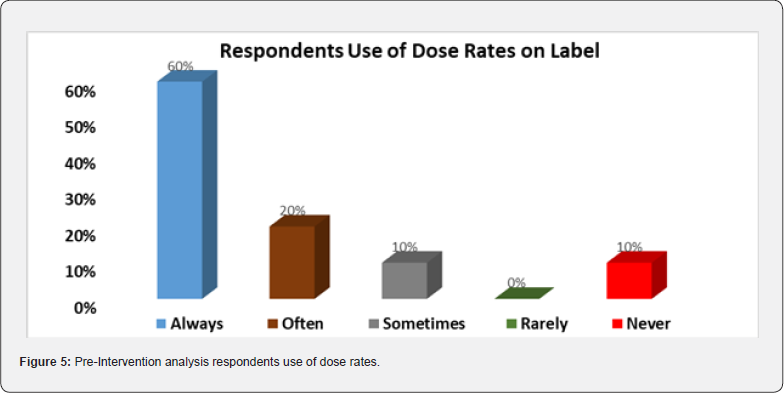
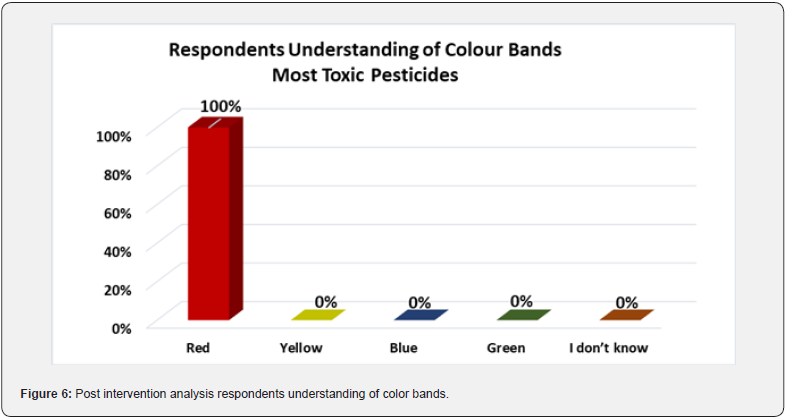
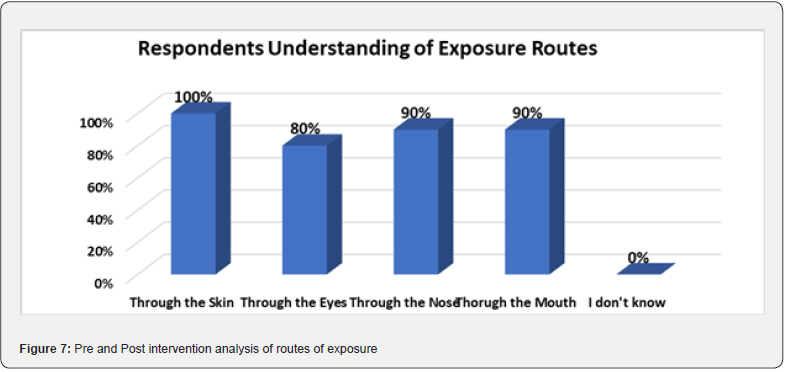
Analysis of general outcomes of the intervention
As the effectiveness of the risk reduction strategy in educating farmers on the safe use, handling, storage and disposal of pesticides was examined, it was observed in general that the training and awareness were well received by farmers. Figure 11, presented below highlights the participant’s views of the training and awareness program. In general, participants found the information shared and topics covered useful (100%), relevant to the group (100%), clear in presentation and tailored to the target audience (100%) to ensure as much knowledge gain as possible. Ninety percent (90%) reported that the venue was suitable while 10% of the participants were not satisfied with the selected venue (Figure 11). Farmers training for the most part in Guyana is usually conducted at the home of a willing farmer within the selected training area. Also 10% of the surveyed farmers requested a hard copy of the information shared, which in his opinion can be reviewed and referenced periodically especially during the nontraining period.

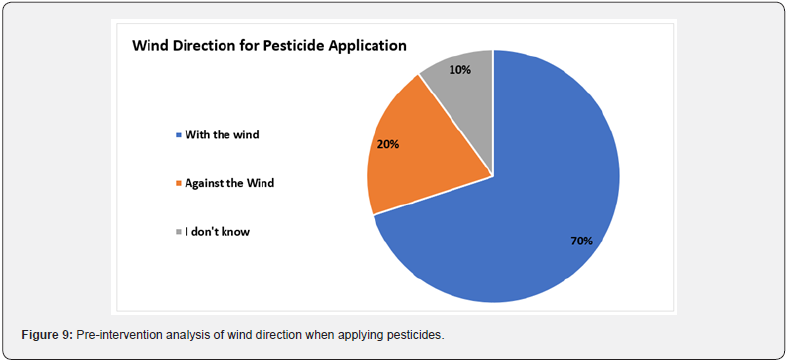
All the surveyed farmers expressed satisfaction with the training and awareness program and indicated their openness to additional training. However, 40% of those surveyed highlighted the need for continuous training in this area, with a few recommending that such programs be conducted on an annual basis. Further, 100% of those surveyed indicated that they have gained knowledge from the training provided on the safe use, handling, storage, and disposal of pesticides. The magnitude of knowledge gain is examined in detail and presented in the result section of this report above. In addition, all surveyed farmers believe that the initiative to train and educate farmers in farming communities can benefit others, based on their experience, knowledge gain, and usefulness of the information shared during the training and awareness exercise. However, many requested more specific information on the various pesticides and target pests, while considering the specific crops grown in the community. (Figure 12)
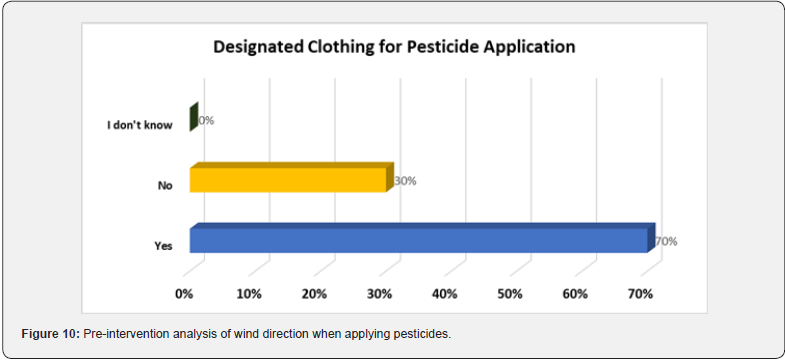
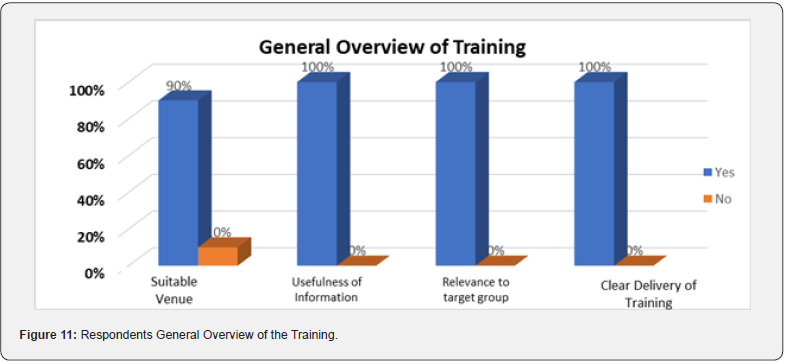
Discussion
Globally, the use of pesticides is growing day by day, but the use of PPE in developing countries is still low and farmers are directly exposed to chemicals that have negative health issues [10]. The present study examined several areas in this regard and found similar results as reported by many other researchers who have conducted alike research. The details are discussed below.
Respondents’ knowledge of pesticides
The results of this present study showed a 60% gain in understanding of the respondents that all pesticides are poisons, while 80% of respondents demonstrated an increased understanding that pesticides can impact human health and the environment. Similar studies were carried out by Shammi et al. [2] where the levels of perception and behavior of farmers regarding pesticide uses and its relevant risks to the environment and human health were surveyed among the farmers of Bangladesh in two areas: Savar Upazila (SU) and Mehendiganj Upazila (MU). These researchers reported parallel findings where significant differences were observed between the farmers regarding information on pesticides. A separate study by Rijal et al. [11] also found that 90% of growers were aware of the adverse effects of pesticides on human health and the environment. Also, Kilonzi et al. [3] reported that most farmers agreed that pesticides posed health risks (85%) and (90%) environmental impairment. Further, results from the present study indicates that forty percent (40%) more of those surveyed before training now understand that there are alternatives to toxic pesticides such as bio-pesticides. In the studies conducted by Kilonzi et al. [3] similar findings were reported. In this case, the researcher found close to 100% of the farmers were unfamiliar with the use of lesser toxic alternatives such as biologicals or bio-pesticides. Likewise, Thapa et al. [10] reported similar results to this present study where the use of biopesticides was not used or less used among farmers in Nepal and should be encouraged as they are most promising and eco-friendly. Likewise, the study by Nwadike et al. [12] concludes with the need to develop an approach that will help strengthen capacity-building programs and enhance knowledge base initiatives around the adoption of non-synthetic pesticides.

Respondents’ knowledge of vulnerable groups
In the present study ninety percent (90%) of the respondents reported that farmers and children are most at risk, while 80% reported both women and the elderly are at risk of experiencing the adverse effects of pesticides. It was observed that respondents were capable of identifying the vulnerable groups most at risk of pesticide exposure and poisoning. However, the study by Lim et al. [1] found no significant difference was observed in the baseline based on gender and age distribution between the pre and postintervention groups.
Respondents’ use of dose rates
The result from this present study indicates that respondents were reading the pesticide labels. Even though 80% of the respondents demonstrated knowledge and understanding of information that is available on pesticides, only 60% indicated that they would always use the dose rates provided on the label, 20% often and 10% sometimes. Like findings were reported by Kilonzi et al. [3]. These researchers found that only 30% percent of farmers who were surveyed could read and understand chemical labels. Similarly, Thapa et al. [10] found that 45.2% of the participants confirmed that they normally read the labels provided in pesticide bottles and sachets. Additionally, the present study found that 60% of the respondents understand that using higher or lower dose rates is incorrect, and 100% of them agreed that the dose rates stipulated on the label should be used. While some knowledge gained by the respondents can be seen, it is important to recognize the importance of the dose rates and the dangers that using higher or lower rates can have on humans, crops, pests, and the environment. Eldridge [13] reported that improper pest control practices may be at fault in many instances when pesticide fails to give effective control. Once such practice identified that the recommended rates of pesticides not applied, either higher or lower rates, among other factors such as unfavorable weather, the pesticides not being timed and applied properly, etc., these improper practices can lead to other issues such as buildup of pesticide resistance by the pest.
Respondents’ understanding of color bands
Results from this study indicated that 90% of the respondents indicated that they were aware that pesticides have varying toxicity classes before the training and awareness exercise, while 90% of the respondents were able to identify that class I pesticides are more toxic than class III pesticides with 100% having knowledge of color bands and corresponding toxicity levels after the training and awareness exercise. Similar findings were reported by Lim et al. [1] where participants from the interventional group recorded a significant improvement in the mean knowledge and safety practices scores in the first month and fifth months compared to the baseline values before the intervention.
Respondents’ routes of exposure
As it relates to how pesticides enter the body, it is important to note that most farmers (90%) were aware that pesticides can enter the body during the pre-intervention survey. The post-intervention survey served to identify and strengthen their knowledge in this area, revealing that the majority (80 to 100%) are aware of the main routes of exposure. Lim et al. [1] also examined the routes of entry into the body and symptoms manifested upon exposure and found that a community-based educational intervention like done in this present study is a feasible, comprehensive, and effective method for improving the knowledge and safety practices among farmers to reduce short-term exposure to pesticides. Apart from direct exposure Abaineh et al. [14] also found and reported that pesticide residues might be one of the major health risks for farmworkers, consumers, and ecosystems due to the improper use of pesticides.
Analysis of respondents’ use of PPE
From the present study, 80% and 20% of the respondents indicated that PPE was extremely important and very important, respectively during the pre and post-intervention survey. This response was the same before and following the training and awareness exercise. The same was reported by Yuantari et al. [6]. This researcher states that the importance of using personal protective equipment such as hats, masks, goggles, boots, and gloves on agricultural land is known and well-understood by the farmers. However, further reported that in practice, only 3.8 % were wearing glasses and 1.9 % were using boots, while masks they only used consisted of a part of their shirt tied around the mouth. Also, Kilonzi et al. [3] reported that only 36% used personal protective equipment (PPEs) when handling pesticides. Further [6] also found that almost no farmers used personal protective equipment that was standard, in good condition, and complete. Similarly, Thapa et al. [10] found that still the pesticide handling practices followed by farmers are not satisfactory and proper protective clothes are not used while spraying. Pesticides even though they know that PPE is important and must be used for safety when applying pesticides. Zhang and Lu [15] also found and reported that most pesticide end-users took incomplete preventive measures due to a lack of extensive pesticide knowledge and information.
Analysis of Respondents’ on application timing, wind direction when applying pesticides, and other safety practices
One hundred percent (100%) and ninety percent (90%) of the respondents, respectively indicated that the most suitable time for the application of pesticides is morning and evening. Likewise, before the training 20% of the respondents indicated that it was acceptable to spray against the wind, while 10% did not know the correct practice in this regard. However, even with the training 10% still indicated that it is acceptable to spray against the wind. Nevertheless, Kilonzi et al. [3] found that farmers 88% who participated in training and awareness exercises and were more likely to follow pesticide safety precautions. Mahyuni et al. [16] also conclude that farmers must pay attention to the wind direction and spraying route when applying pesticides to prevent negative effects on themselves and other persons in the environment. The training and awareness sessions demonstrated some changes as all the respondents agreed that there should be no smoking when applying pesticides. A similar study by Thapa et al. [10] reported that 88% farmers of SU vs. 82% of farmers of MU consumed betel leaf, tobacco or smoking during spraying. The results from the preintervention revealed 30% do not use designated clothing; while 70% used designated clothing when applying pesticides. However, following the training and demonstration exercise all respondents (100%) reported that they are utilizing designated clothing to avoid unwanted exposure of themselves and others to pesticides. Yuantari et al. [6] also reported similar, where farmers were not wearing long pants and shirts with long sleeves or designated clothing for the application of pesticides and in tended use the same clothes for more than 1 day without washing. Shammi et al. [2] reported that only 14% and 5% of farmers reported the full use of PPE in both areas, Savar Upazila (SU) and Mehendiganj Upazila (MU), in Bangladesh respectively. Also, Kilonzi et al. [3] reported that trained and educated farmers were more likely to follow pesticide safety precautions (88%).
Analysis of respondents’ response on access to pesticides and storage, disposal of empty pesticide containers
In Guyana, unwanted access to pesticides is a serious concern as this has often been linked to its high suicide rate. Similar sentiments were put forward by Nwadike et al. [12]. However, after the training and awareness exercise all (100%) participants agreed that pesticide storage is important and to store pesticides correctly, mainly under lock and key, away from food, animal feed, children and/or unauthorized personnel. Nwadike et al. [12] also conclude that the safety behaviors of Farmers are influenced by socioeconomic factors, including educational level, age, and years of farm practice experience. Kilonzi et al. [3] also reported that most farmers (86%) had no standard storage facility for pesticides. Likewise, Koju et al. [17] found that more than 90% of respondents still store their pesticides at home and very few store them at the farm site.
Analysis of respondents’ responses on disposal of empty pesticide containers
This study found that farmers were disposing of pesticide containers poorly and improperly. Similar was reported by Nwadike et al. [12]. The researcher found that 30.6% of farmers frequently use empty pesticide containers for other secondary uses on the farm or at home as well as farmers’ age had and influence on the use of the empty pesticide containers for other secondary purposes. Also, the results from the post-intervention survey reveal that all (100%) farmers agreed to better disposal practices of empty pesticide containers. Likewise, Nwadike et al. [12] reported that education attainment significantly influenced the use of pesticide containers for other farm secondary or domestic uses. Kilonzi et al. [3] also found that poor disposal of chemical leftovers and empty containers was evident in his study. Similarly, Moreira and Da Silva [7] found that the most frequent risk behavior of participants was the application of pesticides without personal protective equipment (PPE), incorrect disposal of empty packaging and waste, and undervaluation of label information, as well as other unsafe practices.
Analysis of general outcomes of the intervention
Overall, as the effectiveness of the risk reduction strategy in educating farmers on the safe use, handling, storage, and disposal of pesticides were examined through the pre and post-intervention findings, the results indicated that there was knowledge gain among all the participants of the training and awareness exercise, coupled with information shared and practical exercises, risk reduction from exposure to pesticides is likely to improve. Additionally, based on the indicators tested in this exercise farmers were able to examine their current pesticide use culture and now have an opportunity to significantly change and adapt to ensure the protection of human health and the environment.
It was observed in general that the training and awareness were well received by farmers. The participants found the information shared and topics covered useful (100%), relevant to the group (100%), clear in presentation and tailored to the target audience (100%) to ensure as much knowledge gain as possible. Ninety percent (90%) reported that the venue was suitable while 10% of the participants were not satisfied with the selected venue. However, it is clearly understood that farmers training for the most part in Guyana is usually conducted at the home of a willing farmer within the selected training area. Also 10% of the surveyed farmers requested a hard copy of the information shared, which in his opinion can be reviewed and referenced periodically, especially during the non-training period.
All the surveyed farmers expressed satisfaction with the training and awareness program and indicated their openness to additional training. However, 40% of those surveyed highlighted the need for continuous training in this area, with a few recommending that such programs be conducted on an annual basis. Further, 100% of those surveyed indicated that they have gained knowledge from the training provided on the safe use, handling, storage, and disposal of pesticides. The magnitude of knowledge gain is examined in detail and presented in the result section of this paper above. In addition, all surveyed farmers believe that the initiative to train and educate farmers in farming communities can benefit others, based on their experience, knowledge gain, and usefulness of the information shared during the training and awareness exercise. However, many requested more specific information on the various pesticides and target pests, while considering the specific crops grown in the community.
Conclusion
Further, based on the information shared with the farmers, the feedback provided, and the knowledge gained it can be concluded that the aims and objectives of the intervention were met. Participants demonstrated renewed knowledge gained on the safe use, handling, storage, and disposal of pesticides. Generally, they were more learned about the concept of pesticides and their impact on human health and the environment. They also highlighted a very good understanding of who are the vulnerable groups to pesticide exposure. Participants expressed increased knowledge gained on pesticide use, handling, application techniques, label, and dose rate after the intervention, However, in practice this may not materialize as they claimed that they do not always adhere to the correct practices when working with pesticides in the fields.
Alarmingly, despite knowing the importance of using the correct dose, many indicated that they would most times use a higher dose for self-belief of actually killing the pest. More importantly, participants showed an excellent understanding of pesticide toxicity and routes of exposure. Their practices in the fields were contrary since many indicated that they do not wear all the required protective clothing when handling pesticides because of the hot and humid climatic conditions in Guyana. Participants displayed very good knowledge and understanding of the storage of pesticides and the disposal of empty pesticide containers. Most of them indicated they practiced proper storage of pesticides under lock and key at home. However, they do not always practice triple rinsing empty pesticide containers and may even dispose of the containers on the dams, waterways, and fields in the back dam.
Challenges/ Limitations faced during the conduct of this study
Despite achieving the overall aim and objectives of the intervention, there were some challenges during the conduct of the exercise such as difficulties with the availability of the participants to conduct the intervention; the selected area of study was very far in the country area and the inclement weather during the period made it difficult to reach the participants. Also, participants indicated that the period coincided with harvesting time and thus some could not attend the training and awareness sessions. This could have been attributed to the reduction in the number of participants that attended the training when compared with the initial target. The initial proposal aims to target 50 farmers, farmworkers, and their family members from the selected communities. However, only 28 persons participated and were beneficiaries of the training and awareness exercise. This reduction in participants from the targeted farming communities was one of the major limitations of the intervention. However, it did not significantly impact the outcome of the exercise. Respondents also indicated that PPE should always be worn when applying pesticides and expressed a willingness to do so, however they did not own up to whether this is commonly practiced. Additionally, the uptake to use PPE by farmers in Guyana is influenced by its tropical climatic conditions.
Lessons learned & recommendations for further work
Farmers demonstrated a fair knowledge and understanding of practicing the use, handling, storage, and disposal even before the training and awareness intervention. However, the actuality of them practicing the same in the fields was not an eventuality indicating that more work must be done to get them to adopt and implement the best practices in safe pesticide handling practices, adoption of PPE and management of pesticides in the farms. Also, the use of biopesticides should be encouraged as they are the most promising and eco-friendly approach.
Additionally, taking into consideration that the practices of farmers generally seen in the study area are a representation of our farmers countrywide, thus, to further protect farmers from different health and environmental issues, training, seminars, and talk discussions should be scheduled and conducted countrywide. Therefore, it would be recommended that this intervention of training and awareness on the safe use and management of pesticides be extended to all agricultural communities throughout the country with the aim of building capacity in these communities ultimately to reduce the risk pesticides pose to human health and the environment.
Acknowledgements
The authors are thankful to the University of Cape Town for providing the opportunity for the Deputy Registrar of PTCCB, Mr. S. Amichand to conduct this research exercise as part of the partial fulfillment of his Degree of Masters in Pesticides Risk Management. Also thankful for the necessary funding and assistance of the Pesticides and Toxic Chemicals Control Board (PTCCB), Mon Repos, East Coast Demerara, Guyana as well for the assistance with the organizing and execution of these studies. Further, thankful for the guidance, support, and contributions of Dr. R. Persaud from the GRDB, Rice Research Station, Burma in putting together this MS. Finally, the authors are also thankful for assistance received from everyone during the conduct of this exercise especially to the support staff of PTCCB, GRDB and Extension Officers from the National Agricultural Research and Extension Institute (NAREI) within the farming community of RPN, region #3 who assisted in one way or another with the organization and execution of this project.
References
- Lim SH, Helmy H, Cheah WL (2023) Effects of an educational intervention on knowledge and safety practices in pesticide handling among farmers in Samarahan, Sarawak. Malaysian Journal of Public Health Medicine 23(2): 255-263.
- Shammi M, Sultana A, Hasan N, Rahman M, Islam S, et al. (2020) Pesticide exposures towards health and environmental hazard in Bangladesh: A case study on farmers’ perception. Journal of the Saudi Society of Agricultural Sciences 19(2): 161-173.
- Kilonzi J, Nyongesa M, Nganga N (2023) Pesticides Handling, Risk Management and Estimation of Exposure Levels in Potato Farming Under Small Scale Production. Research Square p.1-33.
- Leskovac A, Petrović S (2023) Pesticide Use and Degradation Strategies: Food Safety, Challenges and Perspectives. Foods 12 (14): 2709.
- Aldosari F, Mubushar M, Baig MB (2018) Assessment of farmers knowledge on pesticides and trainings on pesticide waste management in central Punjab - Pakistan. Journal of Experimental Biology and Agricultural Sciences 6(1): 168-175.
- Yuantari MGC, Van Gestel CAM, Van Straalen NM, Widianarko Sunoko BHR, Shobib MN (2015) Knowledge, attitude, and practice of Indonesian farmers regarding the use of personal protective equipment against pesticide exposure. Environmental Monitoring and Assessment 187(142): 1-7.
- Moreira A, Da Silva MV (2023) Pesticide Application as a Risk Factor/Behaviour for Workers’ Health: A Systematic Review. Environments 10(9): 160.
- Zyoud SH, Sawalha AF, Sweileh WM, Awang R, Al-Khalil SI, et al. (2010) Knowledge and practices of pesticide use among farm workers in the West Bank, Palestine: safety implications. Environ Health Prev Med 15(4): 252-261.
- Asharose, Saizen I, Sasi PKC (2015) Awareness Workshop as an Effective Tool and Approach for Education in Disaster Risk Reduction: A Case Study from Tamil Nadu, India. Sustainability 7(7): 8965-8984.
- Thapa S, Thapa B, Bhandari R, Jamkatel D, Acharya P, et al. (2021) Knowledge on Pesticide Handling Practices and Factors Affecting Adoption of Personal Protective Equipment: A Case of Farmers from Nepal. Advances in Agriculture 2021: 1-8.
- Rijal JP, Regmi R, Ghimire R, Puri KD, Gyawaly S, et al. (2018) Farmers’ Knowledge on Pesticide Safety and Pest Management Practices: A Case Study of Vegetable Growers in Chitwan, Nepal. Agriculture 8(16): 1-11.
- Nwadike C, Joshua VI, Doka PJS, Ajaj R, Abubakar HU, et al. (2021) Occupational Safety Knowledge, Attitude, and Practice among Farmers in Northern Nigeria during Pesticide Application - A Case Study. Sustainability 13(18): 101074.
- Eldridge BF (2008) Pesticide application and safety training for Applicators of public health pesticides. Training manual prepared by Vector-Borne Disease Section, Center for Infectious Diseases and California Department of Public Health. Accessed March 15: 2024.
- Abaineh A, Ejigu D, Atlabachew M, Dejen E, Tilahun G (2024) Pesticides in use, their application and risks on human health and ecosystems: A case of Fogera District, Ethiopia. Sustainable Environment 10(1): 1-18.
- Zhang H, Lu Y (2007) End-users’ knowledge, attitude, and behavior towards safe use of pesticides: a case study in the Guanting Reservoir area, China. Environ Geochem Health 29: 513-520.
- Mahyuni EL, Harahap U, Harahap RH, Nurmaini N (2021) Pesticide toxicity prevention in farmer's community movement 9(E): 1-7.
- Koju P, Shakya PR, Shrestha A, Karmachary BM, Shrestha S, et al. (2020) Pilot Educational Intervention to Promote Safe Pesticide Use Practices Among Farmworkers in Nepal. Annals of Work Exposures and Health 64(8): 866-875.






























